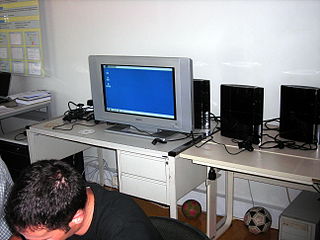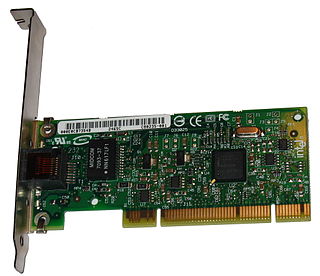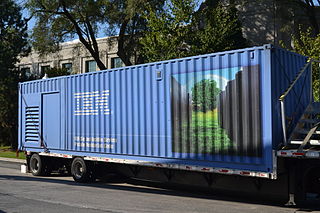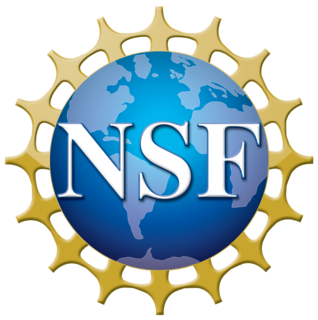In computing, floating point operations per second is a measure of computer performance, useful in fields of scientific computations that require floating-point calculations. For such cases it is a more accurate measure than measuring instructions per second.

Blue Gene is an IBM project aimed at designing supercomputers that can reach operating speeds in the petaFLOPS (PFLOPS) range, with low power consumption.

Quadrics was a supercomputer company formed in 1996 as a joint venture between Alenia Spazio and the technical team from Meiko Scientific. They produced hardware and software for clustering commodity computer systems into massively parallel systems. Their highpoint was in June 2003 when six out of the ten fastest supercomputers in the world were based on Quadrics' interconnect. They officially closed on June 29, 2009.
Rocks Cluster Distribution is a Linux distribution intended for high-performance computing clusters. It was started by National Partnership for Advanced Computational Infrastructure and the San Diego Supercomputer Center (SDSC) in 2000 and was initially funded in part by an NSF grant (2000–07) but was funded by the follow-up NSF grant through 2011. Rocks was initially based on the Red Hat Linux distribution, however modern versions of Rocks were based on CentOS, with a modified Anaconda installer that simplifies mass installation onto many computers. Rocks includes many tools which are not part of CentOS but are integral components that make a group of computers into a cluster.

The National Energy Research Scientific Computing Center, or NERSC, is a high performance computing (supercomputer) user facility operated by Lawrence Berkeley National Laboratory for the United States Department of Energy Office of Science. As the mission computing center for the Office of Science, NERSC houses high performance computing and data systems used by 7,000 scientists at national laboratories and universities around the country. NERSC's newest and largest supercomputer is Cori, which was ranked 5th on the TOP500 list of world's fastest supercomputers in November 2016. NERSC is located on the main Berkeley Lab campus in Berkeley, California.

The considerable computing capability of the PlayStation 3's Cell microprocessors has raised interest in using multiple, networked PS3s for various tasks that require affordable high-performance computing.

Finisterrae was the 100th supercomputer in Top500 ranking in November 2007. Running at 12.97 teraFLOPS, it would rank at position 258 on the list as of June 2008. It is also the third most powerful supercomputer in Spain. It is located in Galicia.
DiaGrid is a large, multicampus distributed research computing network utilizing the HTCondor system and centered at Purdue University in West Lafayette, Indiana. In 2012, it included nearly 43,000 processors representing 301 teraflops of computing power. DiaGrid received a Campus Technology Innovators Award from Campus Technology magazine and an IDG InfoWorld 100 Award in 2009 and was employed at the SC09 supercomputing conference in Portland, Ore., to capture nearly 150 days of compute time for science jobs.
Clarence Leroy “Ben” Coates was an American computer scientist and engineer known for his work on waveform recognition devices, circuit gates and accumulators.
QPACE is a massively parallel and scalable supercomputer designed for applications in lattice quantum chromodynamics.
System G is a cluster supercomputer at Virginia Tech consisting of 324 Apple Mac Pro computers with a total of 2592 processing cores. It was finished in November 2008 and ranked 279 in that month's edition of TOP500, running at 16.78 teraflops and peaking at 22.94 teraflops. It now runs at a "sustained (Linpack) performance of 22.8 TFlops". It transmits data between nodes over Gigabit Ethernet and 40Gbit/s Infiniband.

The Minnesota Supercomputing Institute (MSI) in Minneapolis, Minnesota is a core research facility of the University of Minnesota that provides hardware and software resources, as well as technical user support, to faculty and researchers at the University and at other institutions of higher education in Minnesota. MSI is located in Walter Library, on the University of Minnesota’s Twin Cities campus.

Japan operates a number of centers for supercomputing which hold world records in speed, with the K computer becoming the world's fastest in June 2011.

Several centers for supercomputing exist across Europe, and distributed access to them is coordinated by European initiatives to facilitate high-performance computing. One such initiative, the HPC Europa project, fits within the Distributed European Infrastructure for Supercomputing Applications (DEISA), which was formed in 2002 as a consortium of eleven supercomputing centers from seven European countries. Operating within the CORDIS framework, HPC Europa aims to provide access to supercomputers across Europe.
Carter is a supercomputer installed at Purdue University in the fall of 2011 in a partnership with Intel. The high-performance computing cluster is operated by Information Technology at Purdue (ITaP), the university's central information technology organization. ITaP also operates clusters named Steele built in 2008, Coates built in 2009, Rossmann built in 2010, and Hansen built in the summer of 2011. Carter was the fastest campus supercomputer in the U.S. outside a national center when built. It was one of the first clusters to employ Intel's second generation Xenon E-5 "Sandy Bridge" processor and ranked 54th on the November 2011 TOP500 list, making it Purdue's first Top 100-ranked research computing system.
Rossmann is a supercomputer at Purdue University that went into production Sept. 1, 2010. The high-performance computing cluster is operated by Information Technology at Purdue (ITaP), the university's central information technology organization. ITaP also operates clusters named Steele built in 2008, Coates built in 2009, Hansen built in the summer of 2011 and Carter built in the fall of 2012 in partnership with Intel. Rossmann ranked 126 on the November 2010 TOP500 list.

The high performance supercomputing program started in mid-to-late 1980s in Pakistan. Supercomputing is a recent area of Computer science in which Pakistan has made progress, driven in part by the growth of the information technology age in the country. Developing on the ingenious supercomputer program started in 1980s when the deployment of the Cray supercomputers was initially denied.
ScREC is a supercomputer developed by the Research Centre for Modeling and Simulation (RCMS) at the National University of Sciences and Technology, Pakistan (NUST) in Islamabad, Pakistan. With a 132 teraflops performance, it is currently the fastest supercomputer in Pakistan.



















